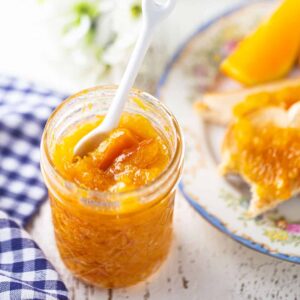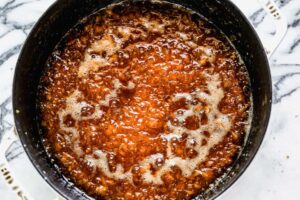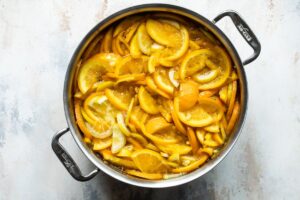Lemons and oranges are some of the most versatile fruits available. Besides serving as ingredients in recipes, they also add flavor to water and tea, brighten up salads, and can even be used as natural cleaners! Perhaps one of the most popular uses of these citrus fruits, however, is to make orange marmalade. This recipe will show you how to make orange marmalade at home using the stove top method, so you can enjoy this sweet-tart spread on toast or bread year-round.
- Table of contents
- What is it?
- Recipe
- Ingredients
- Video Guide
- Taste
- Tips
- FAQs
What is Orange Mermelada?
Orange mermelada is a vegetarian preserve made from oranges that have been cooked with sugar, water, and a little lemon juice for flavor. Oranges have the ideal balance of tangy and sweet flavors. This jam is a mouthwatering explosion of fresh fruit flavor.
Making orange mermeladas involves using the right proportions of fruit, water, and sugar, cooking the fruit and water over a low heat until the fruit is softened, adding the sugar and stirring it in to dissolve it, and then cooking the mixture until it reaches setting point. Instead of using a tall, narrow pot, it is advised to use a wide pot with a large surface area because it will hasten the cooking process and lessen the likelihood of a dark, overcooked jam.
Marmelade, a French word that was derived from the Galician-Portuguese word marmelada, was the source of the word “marmalade” before it first appeared in English in 1480. Portuguese-made marmelada—thick mixtures that were brought from Portugal to England as early as 1495—is where English marmalade gets its name. Despite being the modern citrus preserve, the original version of this was a quince paste. In some European and Scandinavian countries, it is still used today, though in different forms, to refer to many different types of fruit preserves.
If you can find them, the Seville orange is the traditional mermelade orange. Because mandarins don’t have as much pectin, making mandarin marmalade is more difficult. Making lemon and ginger jam is really enjoyable because it has a lot of pectin and will set quickly. Making ruby grapefruit is also fairly simple.
For a delicious breakfast on the go for your family every morning, orange mermelada pairs best with bread or freshly baked croissants. You can spread it on a crunchy cracker, roll it up in a chapatti, stir it into milk, or make a variety of bread and jam delights for your kids’ breakfast. You will find the burst of orange flavor to be an odd flavor.
Orange Marmalade Recipe

Recipe: Orange Marmalade Recipe
Category: Desserts, Appetizer
Cuisine: American
Author: LHH Food
Preparation Time:
Cooking time:
Ingredients: Ingredients list here
Instructions: Click to go to process
Servings: 7
Average rating: 4.9 of 5.0 from 104 reviews
Tags: orange mermelada, orange mermelada recipe, orange mermelada food, how to make orange mermelada, orange mermelada recipe video, easy method of making orange mermelada, video on how to prepare orange mermelada, how to prepare orange mermelada, orange mermelada instructions video, orange mermelada recipe methods, orange mermelada recipe tips, orange mermelada recipe pictures, orange mermelada preserve photos, orange mermelada step by step instructions, orange mermelada cooking methods, orange mermelada methods, orange mermelada cooking directions
About: Orange Mermelada easy recipe from LHH Food. Learn how to make your orange mermelada from home.
Orange Mermelada Ingredients
- 4 medium oranges
- 1 lemon, zest and juice of
- 1/3 cup water
- 4 cups granulated sugar
How to make Orange Mermelada
- To begin, sterilize your jars and lids by washing them in hot soapy water, then thoroughly rinsing and drying them. Dry the jars by turning them upside down.
- Prepare your fruit next. Wash the oranges and lemon in warm water and pat dry with a clean towel.
- Cut the oranges’ ends off. Cut the oranges in half, then thinly slice them. If you prefer, you can cut them into quarters.
- In a food processor, pulse/chop the orange pieces until the rind is in very small pieces. Place a plate in the freezer to aid in later testing for doneness.
- In a large saucepan, melt the sugar, then add the oranges and lemon juice. Stir in the water gently to mix well.
- Cook until the sugar has dissolved and the fruit is soft in the saucepan over low heat. This process could take up to 45 minutes.
- When the fruit has softened, turn up the heat and bring the mixture to a boil. Cook for 10 minutes, or until the marmalade thickens slightly. When done, it should slide off the spoon in sheets rather than droplets, and a spoonful poured onto a cold plate should have the consistency of a soft gel that moves slightly. If it is thin and runs easily on a cold plate after pouring, it is not ready; continue cooking.
- Take the pan off the heat.
- Spoon the hot marmalade into the sterilized jars, then cover with lids.
- Let the jars or containers to cool completely before storing them in a cool, dark location. The marmalade can be stored for up to 3-4 months.
Recipe Video: How to make Orange Mermelada
Learn how to make orange mermelada. This is a video on how to prepare your orange mermelada.
Orange Mermelada Tips
- You need really good fruit to make a great marmalade. It tastes best when picked fresh and prepared the same day.
- The sweet-sharp balance and appearance of your preserve will depend on the fruit you use.
- Don’t use ordinary oranges such as Valencia oranges as they contain less pectin.
- Regardless of the flavor, always add lemon juice to marmalade. It gives the flavor an advantage. The flavor becomes more complex as soon as lemon is added.
- Use a good mandolin with a guard or a really sharp knife to slice your fruit thinly.
- After slicing your fruit, you can let it soak at room temperature in the winter overnight or place it in the refrigerator.
- Place a lid on top of it or tightly sealed foil and place it on a very low heat. The skin should then be soft enough for you to be able to press it between your fingers.
- The most challenging thing for people to accomplish seems to be getting marmalade to set, and I’ve found that the best way to determine whether a marmalade is set or not is to use a sugar thermometer.
- Marmalade keeps nice and fresh, zesty and vibrant for a while when kept in a dark place. Even though it might not be in the sun if you leave it out on a kitchen shelf, the light will cause the color to change.
Frequently Asked Questions
What is the difference between marmalade and orange jam?
Orange jam and marmalade are slightly different. Here is the reasoning: Jam is made from the pulp and juice of a fruit, whereas marmalade is made from the juice and peel or rind of a citrus fruit, giving it the delectable chunky bits that give marmalade its delicious flavor.
Oranges are obviously used to make orange jam, but other citrus fruits can be used to make marmalade. However, there is no distinction between orange mermelada and orange jam, if that is what we mean.
What is the ratio of sugar to fruit when making marmalade?
What is the marmalade’s sugar to fruit ratio? Because Seville oranges are sour, marmalade has a 2:1 sugar to fruit ratio.
How do you make orange mermelada less bitter?
Because the rind isn’t cooked properly, marmalade frequently tastes bitter. Cooking the orange rind, also known as the orange peel, thoroughly is one of the most crucial steps in avoiding bitter marmalade.
Additionally, blending different types can be great if you prefer your marmalade to be less bitter. Use grapefruit, lemons, limes, or blood oranges as alternatives. Natural pectin content in citrus fruits is high, making it simple to thicken.
How do you neutralize the bitter taste?
You can’t just keep adding sugar to get rid of bitterness. All you have to do is thoroughly cook your orange. In other words, cook the rind in a few cups of water for up to 10 minutes, then drain it and cook it again in fresh water. Repeat two times more, and you’re ready to add the remaining orange mermelada ingredients.
How do you thicken orange mermelada?
Because the orange rind and lemon juice contain natural pectin, you won’t need to add anything else to thicken your orange mermelada. Pectin is a substance naturally found in apples, citrus, and other fruits that aids in the setting of jams, jellies, and marmalades. Some fruits, such as lemons, have higher levels than others, which is why lemons make a great marmalade, and lemon juice and zest is sometimes added to marmalades made with other citrus.
What does Orange mermelada taste like?
Orange Mermelada pictures



Conclusion
Our homemade orange mermelade is made with our own fresh oranges, which give it a unique flavor. Begin your day with toast and organic jam, a healthy and natural delicacy free of additives, coloring, and preservatives. The key to this marmalade is the use of high-quality orange fruit and an artisan elaboration process.
A tasty breakfast staple, orange mermelade is made from the peels of oranges that have been cooked in sugar until they become soft and spreadable. In this article, you’ll learn everything you need to know about orange marmalade, from how to make it to what kinds of oranges are best for this recipe. If you’re an orange lover, you won’t want to miss it!